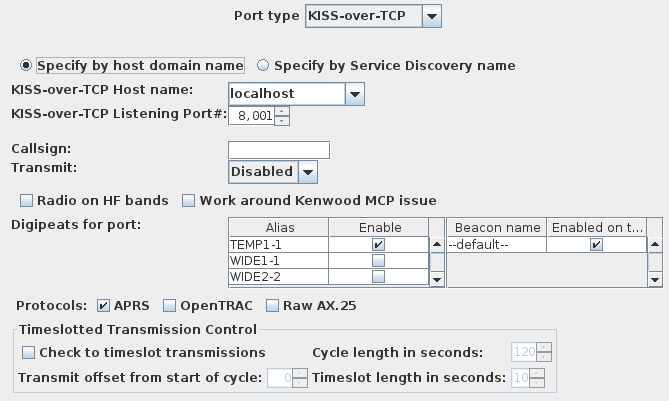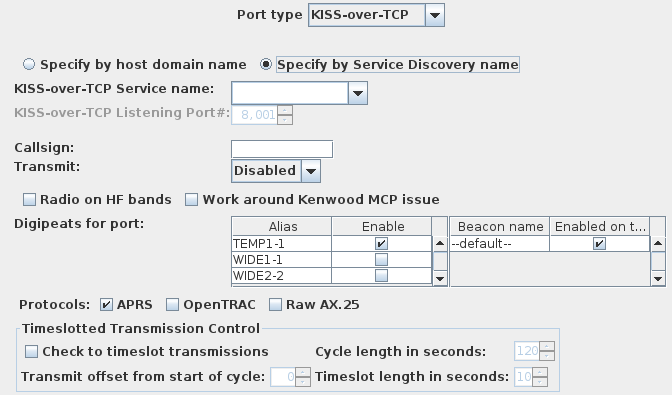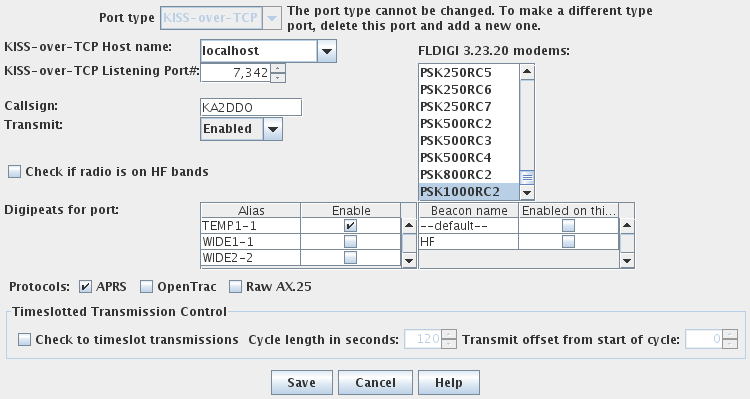Configuring KISS-over-TCP Ports
KISS TNCs can be accessed over a TCP/IP connection. This port type supports such
connections; however, it assumes that the other software providing the TCP/IP server
socket will handle all issues of ensuring the TNC (software or hardware) is in KISS
mode over the socket connection, or that the user will have pre-configured the TNC in KISS mode
(or used a KISS-only TNC) prior to starting YAAC.
To add a new KISS-over-TCP port, click the Add button on the Configure
Ports tab. The port editing dialog will appear. Set the port type
to KISS-over-TCP.

The other parameters you will need to specify for the port are:
- Whether you are going to provide the network connection information for the
remote host manually, or use Service Discovery (if available) to locate available hosts with KISS TNC service
on them. If you choose Host entry, the next two options will be:
- the IP address of the host providing the KISS-over-TCP service; if left blank,
this means the same computer as YAAC is running on.
- The port number for the KISS-over-TCP service, as specified by the application
you are using for KISS-over-TCP. Some port numbers to try are:
| Port number | Application |
|---|
| 8001 | default KISS port for AGWPE and DireWolf |
| 7342 | default TCP KISS port for Fldigi |
| 8100 | default TCP KISS port for VARA-FM |
If you are using a reverse-Telnet TCP/IP-to-RS232 adapter to connect to a
hardware TNC, use the TCP/IP port number specified in the adapter's
documentation for the serial port in use.
If you choose Service Discovery, the panel will change to look like this:

and your next few configuration fields will be a drop-down list of the
names of the discovered services on your network (which may be empty). YAAC searches
for _kiss._tcp services on your local network. Currently, only DireWolf is known
to be able to register itself with your local network's service discovery servers,
although you could manually register with service discovery a reverse-Telnet terminal
server connected to a hardware TNC. Also note that Service Discovery in YAAC only works on
computers running the Avahi daemon for mDNS and DNS-SD service (typically, Linux systems).
It does not yet have access to the Apple Bonjour™ service on Macintosh
computers, and it is unknown whether raw mDNS access will work on Microsoft Windows systems.
- The KISS device ID to use for sending and receiving data on this port. Unless
you are using the antique wiring for connecting multiple TNCs to a single hardware
serial port, or are using a modern software TNC (such as AGWPE or DireWolf) that
supports multiple simultaneous radio ports, this should be left at zero.
- The callsign you will be using to identify your transmissions
over this port. This should be your legal government-assigned
callsign with an optional numeric SSID suffix from 1 to 15.
- Whether or not you want to allow YAAC to make transmissions
through the port. If left disabled, you will only be able to
monitor APRS traffic through this port. You must specify a callsign
to be able to transmit.
- Whether the radio on this port is tuned to the HF bands. By default,
YAAC assumes usage on the VHF and UHF bands where higher bandwidths are
permitted and digipeating is normally used.
- Whether your TNC is a Kenwood radio with built-in TNC that may react to certain
character sequences as commands from Kenwood's Memory Control Progran (MCP) that would
misconfigure the radio. Unless you are using a Kenwood radio's built-in TNC, this should
be unchecked.
- The sub-list of aliases that will be digipeated through this
port, based on the total list of known aliases defined in the
general configuration. If
YAAC receives a message with one of the checked digipeat aliases
and this port is enabled for transmission, the message will be
re-broadcast through the radio on this port. If no aliases are
selected, this port will not digipeat. Multiple aliases can be
selected. The aliases must also
be enabled for digipeating on the configuration dialog's Digipeat tab.
- Which of potentially several beacon definitions will be transmitted
through this port. If none is checked when the port configuration is
saved, the default beacon will be used (and will show up as checked when
this configuration panel is next opened). To specify that a beacon should
not be sent out this port, a beacon should be selected that is not enabled
on the Beacon tab of the expert-mode configuration dialog.
- The protocols that can be transmitted through this TNC. Generally, only one
protocol should be used on a given RF channel to avoid confusion of other stations
and wasting of bandwidth. Which supported protocols should be transmitted out
a TNC port is specified by checking the corresponding checkboxes.
Note that YAAC will support receiving all protocols through one TNC port, recognizing
which protocol is in each AX.25 frame by the PID field; this merely restricts which
protocols YAAC will send on a port. The "raw AX.25" protocol supports connected-mode packet operation.
- Whether transmission through this port should be delayed until an assigned timeslot
at some offset after the beginning of a repeating interval, and whether duplicate packets should be coalesced
into a single transmission instead of retransmitted. Transmitting a burst of duplicates may be useful for
modes like meteor-scatter, where only one or two of a burst of packets may get through, but is otherwise discouraged.
Once you have the settings the way you want them, click OK. Ensure
that the KISS-over-TCP service providing software is running on the
target host before you click OK. At that
time, YAAC will begin using the KISS protocol over the TCP/IP socket
connection as a communications proxy.
Should the remote TNC you have connected to actually be an instance of
W1HKJ's FLDIGI program, invoking the configuration window when the
connection is established will display additional information:

To the right will be displayed a list of all the FLDIGI OpModes (or modems)
that the attached instance of FLDIGI supports in KISS mode (i.e., capable
of sending 8-bit binary data packets) with FLDIGI's currently selected mode also
selected on the list. Clicking on an entry in the list
will command FLDIGI to switch to that OpMode.
If you want to create a KISS-over-TCP port on a new installation of YAAC using the
-createport option, the
port_description is of the format:
KISS-over-TCP,serverhostname,portNumber,callsign,,transmitEnabled[,digipeatAlias[,...]]
where serverhostname is the domain name or numeric IP address of the KISS-over-TCP server instance
you wish to connect to, such as 127.0.0.1,
portNumber is the TCP port number of the KISS-over-TCP server (8001 if accessing DireWolf, other values for other servers),
the extra comma after callsign is to skip the unused passcode field,
transmitEnabled is either "true" or "false" (without the quotes)
depending on whether you want this port able to transmit packets. Any digipeatAlias specified here must also already be
specified on the expert-mode configuration dialog's Digipeat tab.


